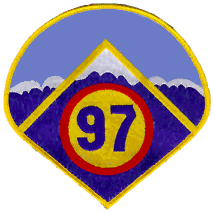Adventure! Troop 97
for boys & girls

Fort Collins,
Colorado USA
www.troop97.net
Troop 97's unusually active outdoor program emphasizes backpacking because this develops ability in all outdoor skills, as well as teamwork and leadership. THERE IS NO NEED TO RUSH OUT AND FULLY EQUIP YOUR SCOUT. Starting with a minimum of gear allows Scouts time to determine the extent of their commitment to Scouting and to learn for themselves from their patrol what equipment is most suitable for lightweight, low-impact camping. Please seek the advice of the troop leaders about major purchases. See especially Chapter 9 of the Scout Handbook (page 256). Troop 97 does not allow glass containers, non-folding (sheath) knives, candles, butane lighters, or electronic devices & games (quiet electronics allowed on our occasional long trips).
RENTAL—Most outdoor stores rent backpacks, sleeping bags, skis, etc. Many stores offer a Scout discount on both rentals and purchases (it never hurts to ask).
HOME-MADE GEAR—Be daring! Make some gear yourself. All you need is a sewing machine and a willingness to try. Many of our Scouts have sewn their own gaiters, stuff sacks, sleeping bag liners, rain pants,...
BICYCLING HELMETS—BSA requires all Scouts and adults to wear proper helmets while cycling, including to and from troop meetings.
BACKPACK—A Scout can use a duffel bag or similar until he can get a good quality pack and frame. A Scout will quickly outgrow or wear out an inadequate pack. Eventually, an active Scout will need a good nylon pack on an aluminum frame of the right size and design, with a padded, wraparound (one-piece) hip belt.
WATER BOTTLE—Get a one-liter (1 qt), wide-mouth plastic water bottle. This is lighter and costs less than a metal canteen, and the plastic won't corrode inside (and the wide mouth is much easier to fill and clean). In winter, some campers bring an extra water bottle to fill with hot water just before bed. Put that inside your sleeping bag, and it will stay hot for up to several hours (but be sure it won't leak!). And in really cold weather, it's not a bad idea to put your regular water bottle in your sleeping bag, too, to keep it from freezing (again, be sure it won't leak).
SLEEPING BAG—The sleeping bag should be a good, machine-washable, four-season bag, weighing four to five pounds. The BETTER artificial fibers are preferable to down because they cost less, are easier to wash, and provide warmth even when wet. A Scout can use a blanket roll until you can acquire a good bag. He can also augment his bag in winter with an extra blanket or two.
SLEEPING BAG LINER—Try making a simple sleeping bag liner out of polar fleece. This adds warmth, and the easily-washed liner collects dirt and sweat instead of the bag. There are also silk or polyester liners that will add 5 to 10 deg. F, but they are much more expensive.
SLEEPING PAD—A pad is useful year round and is essential in winter. Twice as much body heat is lost into the ground as the air! A pad insulates better and costs less than an air mattress. Buy a closed-cell foam (such as Ensolite; this is waterproof and costs less than an open-cell foam such as foam rubber, which require a waterproof cover). Self-inflating pads (like Thermarest) are nice for adult campers, but they are expensive and require care.
GAITERS—These leggings fit between the boot top and knee and keep snow from soaking pants legs, socks, and boots. They are necessary for comfort when snow camping. Gaiters are easily made from a pattern.
STUFF SACKS—A pack should be a "bag of bags". Nylon stuff sacks keep clothing and gear dry and findable inside the pack. You can easily make stuff sacks of various sizes from scrap nylon, closed by Velcro or drawstring.
KNIFE/AXE/BOWSAW—A folding pocket knife can be handy, but is not required. Hatchets and axes may be fun, but a bowsaw is quicker, safer, and easier to use. The troop bans any non-folding knife or any personal hatchet or axe.
TENT—Please consult with the Scoutmaster before investing in a personal tent (tents need to be four-season, backpacking tents).
FOOTGEAR—For warm-weather outings, hiking boots should be the lightest weight and least expensive pair you can find that are comfortable and have lug soles. Because of kids' rapid growth, you don't need top-quality boots, but proper fit is vital. Hiking boots should be comfortable right from the start (never buy boots that need to be "broken in"). Sneakers are acceptable only as a backup to proper hiking boots, and sneakers are never acceptable in winter.
For winter camping, you need warm boots with removable felt liners. The "Sorel" brand is a good choice for adults and older Scouts whose feet are not growing fast, but younger Scouts can do fine with less costly snowmobile or moon boots, as long as these have removable felt liners.
STOVE/COOK SET—Because of the nature of snow camping and the increasing restrictions on back-country camping, we do most of our cooking on one- or two-burner propane, butane, white gas, or alcohol stoves. Please consult with the Scoutmaster before purchasing a backpacking stove. The troop owns patrol cook sets. A Scout needs his own plate, cup, and silverware.
SOURCES OF EQUIPMENT—There are many local outdoor stores. Price and quality usually go hand in hand. Talk to the troop leaders if you have any questions.
Last Revision to This Page: 30 November 2018
Copyright © 2018 by Troop 97 BSA